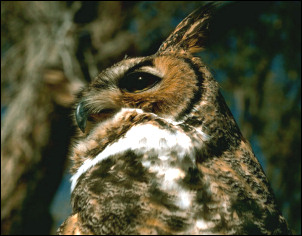
ContextKingdom: AnimaliaPhylum: Chordata Subphylum: Vertebrata Class: Aves Order: Strigiformes Family: Strigidae |
 |
Great Horned Owl (Bubo virginianus). Photograph by Gary M. Stolz, courtesy of the U.S. Fish and Wildlife Service. |
The Great Horned Owl is highly recognizable for the feather tufts on its head that resemble horns. It is the largest owl found in the Americas. The upper parts of the owl's body are sooty brown with gray-brown mottling, and its dark underparts make its white throat stand out. Adults measure approximately half a meter in length, have a wingspan range of 0.91-1.52 m, and weigh 900 to 1800 g (Lewis, 2006). Females are slightly larger than males (Carolina Raptor Center, 2006)
Bubo virginanus is found throughout the Americas in a great variety of different habitats, from cold northern coniferous forests to hot deserts (National Audubon Society, 1983). However, it tends to be more common in wooded areas (Bent, 1938). They have the most extensive range, widest prey base, and most variable nesting sites of any American owl (Carolina Raptor Center, 2006)
Bubo virginanus is a most formidable predator. Its prey consists primarily of small vertebrate animals (Lewis, 2006). When available, it seems to prefer cottontail rabbits above all other prey animals (Bent, 1938). Recorded mammalian prey items include but are not limited to rodents of all types, lagomorphs, small-to-midsized mustelids, opossums, domestic cats, bats, and shrews. It hunts bird species ranging from sparrows and crows to chickens and grouse to other raptors such as adult Red-Tailed Hawks and fellow owls to turkey and geese. Other miscellaneous prey animals include various snakes, frogs, dace, goldfish, bullhead catfish, eels, perch, crayfish, Jerusalem crickets, beetles, grasshoppers, katydids, and scorpions (Bent, 1938).
Bubo virginianus is a poor nest-builder and consequently relies on utilizing the nests of other birds, such as hawks and crows, when possible; variations ranging down to small squirrel nests have also been utilized (Bent, 1938). If a desired nest is currently inhabited, the owls usually succeed in forcibly stealing it. It nests in late winter to early spring. The female lays 2-3 spherical white eggs (Axley, 2001). The young hatch in about 4 weeks and become independent from the parents within 1-2 months (Carolina Raptor Center, 2006).
Axley, E. 2001. "Bubo virginianus" (On-line), Animal Diversity Web. Accessed 15 March 2006 at http://animaldiversity.ummz.umich.edu/site/accounts/information/Bubo_virginianus.html.
Bent, A. C. 1938. Life histories of North American birds of prey, Part 2. Washington D.C., U.S. Government Print Office, 482 pp.
Carolina Raptor Center. Great Horned Owl. Accessed 15 March 2006 at http://www.carolinaraptorcenter.org/gh_owl.php
Lewis, D. P. (compiler). Great Horned Owl - Bubo virginianus. Accessed 15 March 2006 at http://www.owlpages.com/owls.php?genus=Bubo&species=virginianus.
National Audubon Society. 1983. Audubon Society master guide to birding. Alfred A. Knopf, New York, 279 pp.
Alessandro Crinzi, March 2006.
